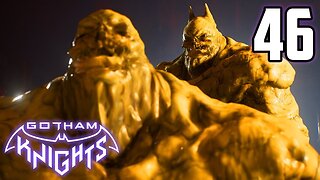Premium Only Content

Incredible Story of Zana, Captured Bigfoot. Shocking DNA Results Revealed!
THE ZANA AFFAIR
This is the or Zanya, a hairy Wild Woman, known locally as an Abnauayu, or a really Abominable Snowman…Snow Woman in this case, or to some, called an Alma (female is Almasty) or Kaptar (from Khazakhstan), depending on the location. She is a feral relict hominoid from Stone Age prehistory distantly related to human beings, possibly Neanderthal some think.
The species “Homo neanderhalensis” is not an ancestor of modern humans some research indicates, the mitochondrial DNA studies having shown that our two species have evolved separately. They are descended from a separate branch of the human family tree some 516,000 years ago, according to some research published in Nature Magazine. When modern man moved into Europe about 45,000 years ago, the Neanderthals were pushed into the wilds, supposedly going extinct, as the last known Neanderthal fossils are from 24,000 years ago.
In contrast, Svante Paabo, a paleogeneticist at Germany’s Max Planck Institute determined from sequencing the Y-chromosome from a 49,000 year old Neandertal genome that some Cro-magnon’s possibly invited ladies to their cave for sex, and to have hybrid progeny…as any human who has ancestors from outside of Africa (where Neanderthals never lived) has one to four percent Neanderthal genes in their genetic makeup!
Much of this ongoing Zana saga is based on the publications of The Russian scientists: Boris Porshnev, “The Struggle For Troglodytes;” “A Skeleton Still Buried and a Skull Unearthed: The Story of Zana;” by Igor Bourtsev; and from the popular 1996 book, “In the Footsteps of the Russian Snowman,” by Dmitri Bayanov. Hominologists, later they were considered cryptozoologists…people who study unknown creatures. I have little new to add, but have accumulated much of the scattered published information to assemble this article.
Incredibly wild and vicious, Zana was captured with great difficulty in the forest by a local merchant in (about?) 1850, as was said by Apollon Dumaya, a local official who was told by his father of the capture. It was in the Ochamchir Region of Georgia in a gulch along the Adzyubzha River…and the merchant was astonished to see a young female Abnauyu in a meadow along the gulch living in Paleolithic innocence. Incredibly smart and disappearing a second before capture, she was finally outsmarted…the merchant left some red male underwear at the meadow where she was frequently seen and she was caught while putting the underwear over her head and hips.
Named Zana (means black in Georgian) the creature was tied, and fighting back, was hit with cudgels and gagged with a mouth full of felt and finally shackled by her legs to a log. She was eventually put in a ditch, surrounded by a fence of sharpened logs and was living in squalor. There she growled and charged at laughing children who threw sticks and dirt clods at her. After some time she was finally considered somewhat tamed and then made “love” to…even giving birth to live half-breed children…thus, the strange saga of “The Zana Affair.”
Near the end of the last century, Zana was probably sold as a curiosity to the handsome prince, D. M. Achba, titular head of the Zaadan region of Georgia in the late 1800’s. Achba passed this strange slave to his vassal Chelokua, who apparently sold her to the Nobleman Edgi Genaba who was passing through the region at the time.
Genaba took poor Zana in chains and shackles as a slave to the village Tkhina on the Mokva River where his estate was located, some 48 miles from Sukhmia, the capitol city of Abkhazia and near the Black Sea in Georgia.
She was thrown into a caged stone enclosure sans her chains and ropes, and as she acted like a wild beast, food was simply thrown to her. She dug a hole in the ground where she slept for the next three years. Zana was a local curiosity and surrounding villagers would come by to poke her with a stick, chuckling as she would grab for the stick, growl, howl, and menacingly bare her big glaringly white teeth.
Eventually becoming tame, Zana was tethered in a fenced enclosure near the house under an awning. Over time she became domesticated and was released to roam the hillsides free of shackles. Zana did not roam far though, preferring to remain near her food, but she could not endure the warm rooms of indoor human cultures, and slept outdoors, still in a hole in the ground that she had dug under the awning.
Zoologist Professor Alexander Mashdovtsev first heard of and studied the amazing story of Zana, and with Boris Porshnev, gathered many of the following descriptions from locals who still recalled her.
Zana could not speak, even after several decades of living with humans, had never ever learned a word of the native Abhkaz language. She could only make inarticulate sounds, unexpected laughs, mutters or cries when she was poked with a stick or otherwise irritated. One sound done well was the imitation of a squeaking gate, which seemed to make her happy. She could recognize her own name though, and would do simple chores…like carrying with one hand heavy 110 pound sacks of ground corn flour that she had ground from the water-mill by the river, collecting firewood, removing her masters boots, or fetching water. She was fearful when Edgi Genaba shouted at her despite her huge size, but others were afraid of Zana because she was known to bite, and whenever she came to the house, the women only came near when she was in a calm and gentle mood. Adults told Zana-monster stories to their children to make them behave, although Zana was never known to attack any of them…”Zana’s gonna’ get cha’ if your bad.” Perhaps if she was poked with a stick when free?
Zana had features of both Mongoloid and Negroid extraction, and her whole body was very tall with black or dark gray skin, and reddish hair that covered her body like a mass of felt, while on the head it was described as being tousled and a thick shiny black. The thick reddish-black hair then ran down the middle of her back like an animal mane. She was said to be six and a half feet tall, and had huge red eyes. Zana was also broad and had huge buttocks and pendulous breasts, and was quite muscular and could splay her toes wide. Her hideously broad face with high cheekbones and ape-like nostrils turned forward was pure animal though. The muzzle-like jaws had strong sharp teeth…strong enough to crack bones or nuts with. Also quite athletic, Zana could outrun the swiftest horses, or swim the waters of the swiftest river in flood stage at high tide, and do it all the year around. The nearby wild Mouki River was apparently an easy swim with her powerful arms and legs.
Zana hated clothes, preferring to run around naked, even in the coldest winter which she seemed completely resistant to, and if dressed, would tear the clothes to shreds , though she eventually learned to wear a loin cloth. Strange, as she was captured trying to put on red underclothes. Another strange habit was her curiosity about rocks, spending time stacking or cracking them apart. Often she was seen cooling off by lying in a pond with the water buffalo, or bathing in some icy mountain spring. Zana liked to climb trees, or roam the nearby hills, using a stick to fend off dogs or other perils.
Zana was a glutinous eater, taking anything offered her, like meat or hominy, and eating with her bare hands as she never learned how to eat with a spoon and plate.
Often Zena would be seen to climb trees for their fruit, and would pull down and shred grape vines. She drank wine, enough to get quite smashed, lying in a swooning state and sleeping for hours…and the locals learned to give her wine to make her drunk. Perhaps where the term “Monster Mash” came from?
Zana became pregnant several times, from several different fathers…an important clue to geneticists . The local men had forced her to drink wine, and it didn’t take long to get drunk…and then she became sexually aggressive. And, there was always someone to make love to a monster. During drunken orgies Edgi Genaba was said to offer a prize to the man who would mount Zana, and the prize would always be given to a winner…if even himself.
After the birth of a human-type child without assistance, Zana would take the newborn to wash it in the cold waters of the spring or the frozen waters of the river…the first two hybrid babies quickly died from exposure. Eventually the local villagers would take the babies away from the silly mother, nursing and raising the half-monster babies themselves. This occurred four times…two sons and two daughters, who were reared as human. There was an unconfirmed report of another child that ran off to join with mother’s people in the desolate Caucasus Mountains. Seems doubtful though, as the child had to grow up locally and would have probably been named and described.
The sons were the youngest Khwit, and then Dzhanda, while the daughters were young Gamasa and the oldest Kodzhanar. People had no idea who their fathers were, although many years later during a census taking, the children were listed as offspring of a local resident, Kamshish Sabekia, who acknowledged “winning prizes” with Zana before he was finally married. All four of the children adopted the family name of Sabekia. Zana’s youngest son Khwit and his sister Gamasa were raised by Genaba’s wife. It was rumored that they were both sired by Edgi Genaba himself. All the children were fertile, and left descendents scattered across Abkhazia.
The boys had dark-grayish skin and were said to have normal faces, Khwit having thick curly hair and very full lips. Apparently the genes of the father were dominant, overruling the mothers line of descent.
Khwit could work, talk, and reason like other villagers, had a social life, but was powerful, and belligerent…quick to pick a fight. He often had fights with other villagers. Like his mother, Khwit didn’t like children as they would get into his garden to steal pears and grapes…though not poking him like with mom. Khwit was said to be not only a very strong man but was difficult to live with as he was very violent. Khwit once got into a fight with a relative who jumped him. He defended himself but the relative hit him with a mattock and put a deep gash in his right arm near the elbow. The arm had to be amputated, though he could still do his work on the collective farm. A local official recalls the incredibly strong Khwit plowing his lot with only his left arm. Khwit was also said to be able to lift a man in a chair off of the ground with very powerful jaws. Dzhanda, the other son was quite talented and became an accomplished pianist.
Aging, Khwit moved to the town of Tkvarcheli where he finally died. He lived until 1954 being 65 or 70 years old, and was taken back to be buried near his mother Zana, who had died in 1890, in the family cemetery in Tkhina village in the Ochamchiri District of Abkhazia. Some note the importance of Zana being buried in the family cemetery of the Genabas, as if she were part of that family. During her life, she showed little sign of aging, having no grey hair and retained her teeth.
Zana’s grandchildren were also said to be dark skinned, with Negroid features, and extremely strong, and it has been noted by geneticists that the hybrid offspring of Khwit were viable and not sterile. Khwit Sebekia was married twice, and sired two daughters and a son. Igor Bourtsev located most of Zana’s descendents, although one daughter had been electrocuted the prior year of his investigation. Robert Kukubava granted permission for Igor to reproduce photos from the family album. Daughter Raisa and her brother Shuliko are similar to Khwit with similar lower jaws and protruding cheekbones. His older daughter Tatyana has no resemblance to Zana except for the eyes, though photos of Khwit and his sister bear a resemblance to the description of Zana.
Later, several Russian anthropological expeditions attempted and failed to locate Zana’s bones. Also, it had been difficult to obtain permission to disinter the graves in the cemetery. Fortunately an old Abkhazian colleague was appointed as a local council official and was able to grant the necessary permission. Another official, Apollon Dumava, the former council official recalled that his older relatives remembered Zana, and she was said to have curvy hips that attracted the attention of the local men.
The first expedition was in September 1964 when archaeologist V.S. Orelkin and Professor Boris Porshnev searched but were unable to locate the gravesite in the Tkhina cemetery. Returning again in 1965 they were accompanied by Yury Voronov who later became Vice Premier of Abkhazia (but was killed in 1995). The cemetery was located and was found overgrown with bracken fern, but Khwit’s ten year old marked grave mound was easily found. It was said by the last of the family relatives,70 year old Kenton, that Zana’s grave was under a pomegranate tree. Excavating there, only the remains of one of Zana’s grandchildren that had died at an early age was found.
On the next two expeditions, nothing was found, but in October 1965 the possible remains of Gamasa were located and the skull collected. It was small and had definite features that appeared to be paleoanthropic.
After the passing of Prof. Porshnev, young Igor D. Bourtsev and Dimitri Bayanov led expeditions to the area in 1971, 1975, and 1978. They were unable to locate Zana’s grave either, despite digging in adverse conditions; seemingly endless downpours of rain, and in sticky clay earth.
It was then decided in 1971 to locate and excavate Khwit’s grave which was well marked, and remove the skull. Accompanied by the famous Professor of paleontology Nikolay Bourchak-Abramovich assisting with their spade work, Igor Bourtsev excavated the easily located grave of Khwit, removed the skull and took it to Moscow with the other skull that was located. The skulls are now believed to rest at the Moscow State University Institute of Anthropology.
Igor D. Bourtsev, later becoming a cryptozoologist studying unknown species, took the exhumed skulls to Moscow for study of their modern and ancient features. The results from the Khwit skull were published at the Relict Hominoid Research Seminar and the Moscow Naturalists’ Society in 1987, coauthored with M.A. Kolodieva, as “Results of a Preliminary Investigation of a Skull from the village of Tkhina, Abkhaz ASSR” (in Russian).
Physical anthropologists M. A. Kolodieva and M. M. Gerasimova found that the skull was larger than normal male skulls from the region in the collection of the Moscow State University Institute of Anthropology. The facial section of the skull was significantly larger than typical Abkhaz types…the superciliary cranial contour being grater than the maximum of some fossil skulls, and are compared to the Neolithic Vovnigi II skulls of the fossil series at the Institute. It was also noted that the back of the cranium is of the “Homo sapiens” type, without a knot, and that the brow ridge was also of a normal size and had little marking. It was mentioned that the brow ridge of Khwit was even larger than that ascribed to Zana, the supposed Neanderthal…possibly as it was from a male. The overall peculiar features of the skull were also noted in the greater development of the skull’s two foramina mentale of the lower jaw (circular opening in jaw), the intrusive bones of the sagittal suture (across front to back, joins two side parietal bones), and the inca bone (separate skull bone often found in Inca mummies). Gerasiomva, suggests that the skull should have a more detailed study.
Another female skull was unearthed also at the Tkhin cemetery. The skeleton was buried on its side with the legs bent next to Khwit’s grave, with a mirror at the head indicating that it was female. The skull was more robust than that of local women, and was noted to have a large projecting jaw. In the grave was found a rubber shoe branded 1888. From the date, this was assumed to be Zana, and was extremely exciting to researchers, as this would be the first time they had found the remains of an Abnauayu, or Almasty. Except…the anthropological analysis indicated that it was from a black woman who had somehow made it to the Caucuses…now what?
Next, a DNA check was due after the August 2006 Russian newspaper Komsomol’skaja Pravda had an article on the skull examinations from the supposed relic Almasty. Igor Bourtsev was invited to have both skulls analyzed during a visit to the US, and Bourtsev replied on the Mugamir Russian website that he had visited New York July 13th through the 20th (2009) when the DNA of the skulls was examined by the New York University. The results were made public on the National Geographic program, “Is It Real? Russian Bigfoot.” Bourtsev was interviewed and talked with a U.S. geneticist and an anthropologist. The idea was that Zana and her son Khwit were actually Neanderthal hybrids with similar genomes that had possibly survived into modern times, especially now that the entire Neandertal genome has been sequenced and examined by the Max Planck Institute’s Svante Paabo and his team in 2009 in Leipzog, Germany.
Bourtsev said that the examination revealed that one of the skulls was of an Australoid type, possibly that of Khwit, and that the other female skull was of a completely unrelated African type…definitely not that of Zana. The visiting anthropologist said that even though there was a similar DNA relationship between the two skulls, the female skull showed many distinct morphological differences, like a strongly defined lower face and tooth prognathism (stuck out).
Unfortunately for some of us Bigfoot fans…the mitochondrial DNA that was analyzed by the geneticist Todd Disotell from both of the skulls indicated that the shared female maternal relationship was of a human origin…not mutations of the supposed Neanderthal species, as Bourtsev thought, closing a thirty year debate between often belligerent cryptozooligsts. The skull of Zana is still missing, so there is still hope!
This whole Zana Affaur tale reminds me of the popular novel “The Mammoth Hunters” by Jane Auel, telling of the young girl Ayla, living and reproducing hybrids with Neanderthals. I don’t recall if the human genes were dominant over the Neandertal.
I wonder if Zana’s ghost is still searching for her son’s missing head and haunts the local villagers? It is said that Igor Bourtsev while digging through the muck took seriously ill with a strange disease that doctors were unable to diagnose.
Summary
So, what is Zana anyway? Ape, primitive man, or human? It is said that chimpanzee DNA is 98.5% human…not much room to squeeze the Neanderthal, australopithecine, Alma, Sasquatch, and other primitive types between. Most Bigfoot scientists say the creature is an ape, based on the fossil bones of an ancient ape, “Gigantopithecus blacki.” They stick to the idea almost religiously and won’t compromise much. Many Russian investigators have long opted for the Neandertal as a viable model. Perhaps the creature is an ape only in the sense of Desmond Morris describing humans as “The Naked Ape”…then we also are apes along with Sasquatch. Keep in mind that the great apes have 48 chromosomes, while humans only have 45.
The clues lie in the structure of the DNA molecule and the hereditary traits…Zana could give birth to living human types that have grandchildren. There have been a total of 10 cases in Russia or China from 1912 to 1954 of other live births from wild women.
Hotly denied some, more recently, DNA researchers, as opposed to Bigfoot researchers, think that Almas and the North American Sasquatch are human. And that the Sasquatch, Yeran, Kaptar, Yowie (Australia), Yeti, and Mapinguari (Amazon), plus the Alma, are all closely related cousins. My first personal thoughts were of a “Homo erectus (Neanderthal is a descendant of them)” for a model of the Bigfoot that had evolved to different forms in different environments, which even is how Darwin explained the variation in species from Galapogos specimens and observations. Note, the Neanderthal separated from “H. erectus” some 600,000 years ago.
But some few of the scientists thought the often ape-like and often human appearing creatures were probably a form of human, very similar to us. My first exposure was from the geneticist Dr. Ruth McFarland in 1995 who presented evidence of the Washington State Bigfoot as being human at a Carson, WA, conference.
More recently, I have time and again run across DNA evidence that suggested human…but at the time, to the scientists involved, all were “contaminated!” Even a sample I provided from the Zac Cave in Idaho was said to be contaminated.
The Coy/Green Tennessee hair samples are a prime example of where some scientists began to see the light. Dr. Henner Fahrenbach tested a hair taken from the wrist of a Bigoot named Fox, and declared it to be human. Bob Daigle, a friend of Mary Green’s sent a hair sample to be tested for DNA by a geneticist (named only as Dan) who found nothing but human results, the sample sequence being an exact match. He sequenced 300 nucleotides from a mitochondrial gene called clytochrome b, and amplified a 1100 base pair fragment, then ran results against the GeneBank database…human.
Control tests were run that were deliberately contaminated with dog and cat DNA…despite which still the Fox hair sample ended up testing human.
The rest of the general scientific community and senior Bigfoot researchers deniability is reaching the point of being ridiculous. At some point, some very public agency or noted personage is going to declare that the creatures are actually human beings…just different from modern man through a subtle shift in the genetic code. Perhaps just a few genes are involved…though important ones, and they need to be identified.
Once that point has been achieved, perhaps we can gain valuable insight into what the tiny genetic variations are between us and Zana. Those that add up to huge differences…maybe even the solution as to what caused the jump to “intelligence” in Africa some 200-140 thousand years ago when there was a giant intellectual break between “Homo erectus” and modern humans. The answer to why we are US.
Ray Crowe
Oct 31, 2010
ARTICLE SOURCE: https://projectavalon.net/forum4/showthread.php?89321-The-story-of-Zana-Zanya-Zena-a-female-Alma--wild-man--captured-in-1850-in-Georgia
VIDEO SOURCE: https://old.bitchute.com/video/0ACBCgPbkssG/
-
 24:46
24:46
Truths Unlimited
10 hours agoI AM AI. Quantum. StarGate. Pyramids. Obelisks. 369. USA-Babel-Nimrod-Orion-Mt Hermon
661 -
 44:24
44:24
TheTapeLibrary
15 hours agoThe Strangest UFO Encounters Ever Recorded
3722 -
 21:36
21:36
JasminLaine
12 hours agoCarney MOCKS Danielle Smith—Clapback Leaves Him SPEECHLESS, Media Stays Silent
25114 -
 13:46
13:46
ThinkStory
15 hours agoTHE WHITE LOTUS Season 3 Ending Explained!
95 -
 58:09
58:09
CarlCrusher
19 hours agoHunting for UFO Portals on Ancient Ley Lines
134 -
 32:06
32:06
This Bahamian Gyal
12 hours agoGoing BROKE to look RICH | This Bahamian Gyal
563 -
 26:47
26:47
Degenerate Plays
10 hours agoBatman Ended This Man's Whole Career - Gotham Knights : Part 46
262 -
 36:26
36:26
The Screwtape Letters: Confronting Evil in Our Time - Podcast
11 days agoStage 4 to Cancer Free - The Miracle Patient Interview with Dan Thompson
195 -
 30:10
30:10
Afshin Rattansi's Going Underground
1 day agoTariq Ali: Donald Trump’s War Threats Against Iran🇮🇷 is Really About Targeting China🇨🇳
45K57 -
 2:45:19
2:45:19
TimcastIRL
10 hours agoTrump THREATENS 50% Tariff Increase After Market CHAOS, Tells China BACK OFF
253K114